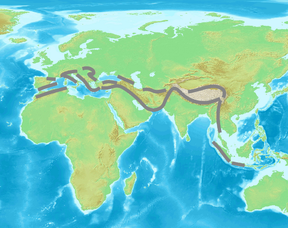| Alpide belt | |
|---|---|
| Alpine-Himalayan orogenic belt | |
 Approximate extent of the Alpide orogenic system | |
| Highest point | |
| Peak | Mount Everest |
| Elevation | 8,848.86 m (29,031.7 ft) |
| Dimensions | |
| Length | 15,000 km (9,300 mi) E–W in the west, N–S in the east |
| Naming | |
| Etymology | Derived from Alps |
| Geography | |
| Mesozoic oceanic platform | Southern Eurasia, northern Africa, central Asian subcontinent, southeast Asia |
| Geology | |
| Formed by | compressive forces at aligned convergent plate boundaries |
| Orogenies | Alpine (in west), Himalayan (in east) |
| Mountain type | Folded mountain ranges |
The Alpide belt or Alpine-Himalayan orogenic belt,[1] or more recently and rarely the Tethyan orogenic belt, is a seismic and orogenic belt that includes an array of mountain ranges extending for more than 15,000 kilometres (9,300 mi) along the southern margin of Eurasia, stretching from Java and Sumatra, through the Indochinese Peninsula, the Himalayas and Transhimalayas, the mountains of Iran, Caucasus, Anatolia, the Mediterranean, and out into the Atlantic.[2]
It includes, from west to east, the major ranges of the Atlas Mountains, the Alps, the Caucasus Mountains, Alborz, Hindu Kush, Karakoram, and the Himalayas. It is the second most seismically active region in the world, after the circum-Pacific belt (the Ring of Fire), with 17% of the world's largest earthquakes.[2]
The belt is the result of Mesozoic-to-Cenozoic-to-recent closure of the Tethys Ocean and process of collision between the northward-moving African, Arabian, and Indian plates with the Eurasian plate.[1] Each collision results in a convergent boundary, a topic covered in plate tectonics. The approximate alignment of so many convergent boundaries trending east to west, first noticed by the Austrian geologist Eduard Suess, suggests that once many plates were one plate, and the collision formed one subduction zone, which was oceanic, subducting the floor of Tethys.[citation needed]
Suess called the single continent Gondwana, after some rock formations in India, then part of the supercontinent of Gondwana, which had earlier divided from another supercontinent, Laurasia, and was now pushing its way back. Eurasia descends from Laurasia, the Laurentia part having split away to the west as a consequence of the formation of the North Atlantic Ocean. As Tethys closed, Gondwana pushed up mountain ranges on the southern margin of Eurasia.
- ^ a b K.M. Storetvedt, K. M., The Tethys Sea and the Alpine-Himalayan orogenic belt; mega-elements in a new global tectonic system, Physics of the Earth and Planetary Interiors, Volume 62, Issues 1–2, 1990, Pages 141–184 Abstract
- ^ a b "Where do earthquakes occur?". United States Geological Survey. Archived from the original on 5 August 2014. Retrieved 8 March 2015.